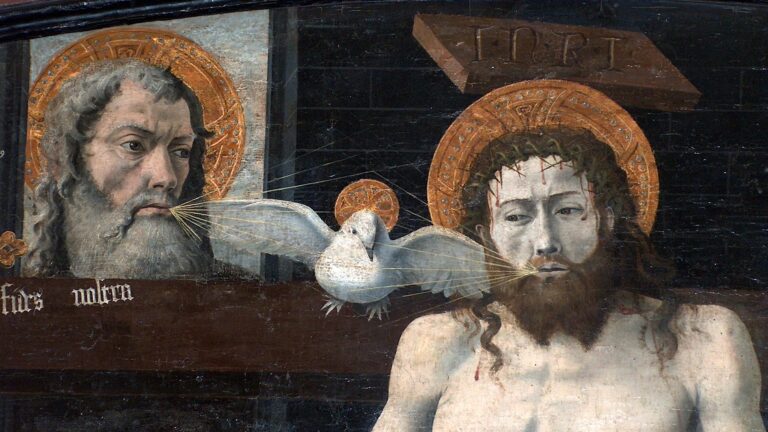This is part 2 of our series on The Greatest Creed Ever Written. You can read part 1 here. This post touches on the background of the Nicene Creed.
For Christians today, the doctrine of the Trinity is surrounded by mystery. We sing songs and hymns that speak of the Trinity:
Let all things their Creator bless,
And worship Him in humbleness,
O praise Him! Alleluia!
Praise, praise the Father,
Praise the Son,
And praise the Spirit,
Three in One!
O praise Him! O praise Him!
Alleluia! Alleluia! Alleluia!
Many other religious groups look at the Christian doctrine of the Trinity and are either offended or scratch their heads. If they were to inquire of the average Christian today, many would not be able to explain what these words mean, though many churches sing them Sunday after Sunday.
Historian Bruce Shelley says that this was not the case in the early church. He writes:
When believers tried to identify God or address God in worship, they inevitably spoke of Father, Son, and Spirit. When asked whom they encountered in the Christian story, they answered in liturgy and preaching, ‘Father, Son, and Spirit.’ Yet when describing God’s nature, they answered that God was one—a unity.
–Church History in Plain Language, 5th edition, 127.
In the early church the Trinity was a topic of regular conversation, not a subject to be avoided. Gregory of Nyssa, a Fourth Century bishop, once said of Constantinople that “If in this city you ask anyone for change, he will discuss with you whether God the Son is begotten or unbegotten.” [1]
However, conversations about the Trinity at the time were often complex. A well known leader and teacher, a man named Arius (256-336), thought that the relationship of the members of the Trinity was simpler and wanted to free discussions from overcomplication. Arius was a leader in the city of Alexandria, which was home to the brilliant (and controversial) theologian Origen (184-230). Origen wrote around 2,000 treatises on various topics and exercised massive influence in the early church. Arius himself was influenced by the teaching of Origen, especially in his thinking about the Trinity. Origen’s writings on the Trinity were ambiguous and controversial. [2]
In the Fourth Century these discussions came to a head when Arius began arguing that Jesus was a created being. Arius, agreed with the general consensus at the time, that God is immutable, He doesn’t change. Change, as Arius and others reasoned, implies imperfection and God is perfect. If he changes, either for good or bad, he has either improved or regressed, which means that God cannot be absolutely perfect. The incarnation (Jesus, adding to Himself a human nature) suggested to Arius that God had somehow changed, which was an unacceptable way of thinking. Arius then reasoned that only God the Father was timeless (without beginning) and that the Son must have came into existence through the will of the Father. He argued that this all happened before Genesis 1:1 (before time began). In the words of Arius: “Before he was begotten or created or appointed or established, he did not exist; for he was not unbegotten.” [3]
Many Christians in that time and place were appalled at this claim. If Jesus was not co-eternal with the Father (having always existed), then He was not truly God. They argued that this put Christian worship, which declared Jesus as Lord, on the same level with pagan worship which worshiped things that were not truly God.
Sadly, in some quarters of the empire, the teaching of Arius spread like wildfire. On one occasion a riot broke out when Arius’ followers stormed the streets of Alexandria (Egypt) chanting, “There was a time when Christ was not!” Before long, the movement had the emperor Constantine’s attention. When Constantine converted to Christianity, he had hoped that the faith would breathe new life into the crumbling Empire. But how could it do that if Christians themselves were not united? He called a council in the hopes of resolving the issue.
The Council of Nicaea, from which the Nicene Creed takes its name, was a gathering of bishops that met in AD 325. In that time and place, bishops had the very important job of keeping order in the church. They were also the ones who helped to decipher truth from error. If a dispute arose over a matter of doctrine or practice, they were charged with preserving the truth and making sure that what was taught in the churches aligned with the teaching of the apostles. [4] Many bishops from across the world responded to Constantine’s call. They met in Nicaea, what is now the town of Iznik in Turkey, not too far from what was at the time called Constantinople (today, Istanbul). This gathering would come to be recognized as the first ecumenical council (a gathering of church leaders from all over the world).
The main order of business before the council was, in the words of scholar Philip Cary, “how to exclude the teaching of Arius from churches throughout the world.” [5]
After rounds of passionate debate, scholar Justin Holcomb writes:
The majority in the council… condemned Arianism. They added to the Apostle’s Creed precise wording to clearly denounce Arianism with the following: ‘We believe…in one Lord Jesus Christ, the Son of God, begotten from the Father [only-begotten; that is, of the essence of the Father, God of God], Light of Light, very God of very God, begotten not made, being of one substance with the Father…”
-Holcomb, Know the Heretics, 91.
At the time they also added anathemas to convey the seriousness of the error that Arius and his followers had made. Their goal was not so much to condemn Arius (which is why they left his name out of the anathemas) but to condemn his teaching: “But as for those who say, There was when He was not, and, before being born He was not, and that He came into existence out of nothing, or who assert that the Son of God is from a different hypostasis or substance, or is created, or is subject to alteration or change – these the Catholic Church anathematizes.”
The anathemas were later removed and there were a few other additions made at the Council of Constantinople in 381. The final version of the Nicene Creed, sometimes called by scholars the Niceno-Constantinopolitan Creed, can be read here. Today, this is the most widely used confession of faith in the Christian world.
[1] As quoted in Bruce Shelley, Church History in Plain Language, 5th Edition, 128.
[2] Justin S. Holcomb, Know the Heretics, 87-89.
[3] As quoted in Holcomb, Know the Heretics, 91.
[4] This was especially true before the time the New Testament was written. At times bishops would meet with other nearby bishops to deal with disputes if something arose that contradicted or challenged a particular point of tradition. Many consider the Council of Jerusalem, mentioned in Acts 15, to be one of the first gatherings of this sort.
[5] See Phillip Cary, The Nicene Creed: An Introduction, 5.



